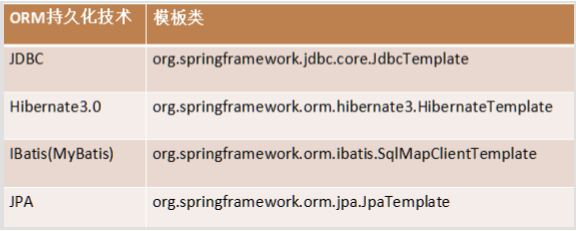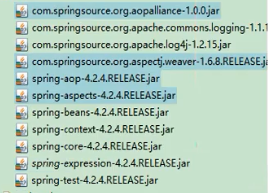SpringMVC学习笔记三 整合jdbc和事务
spring整合JDBC
spring提供了很多模板整合Dao技术,用于简化编程。

引入相关jar包

spring中提供了一个可以操作数据库的对象,JDBCTemplate(JDBC模板对象)。对象封装了jdbc技术。与DBUtils中的QueryRunner非常相似。
@Test public void fun1() throws Exception{ //0 准备连接池 ComboPooledDataSource dataSource = new ComboPooledDataSource(); dataSource.setDriverClass("com.mysql.jdbc.Driver"); dataSource.setJdbcUrl("jdbc:mysql:///hibernate_32"); dataSource.setUser("root"); dataSource.setPassword("1234"); //1 创建JDBC模板对象 JdbcTemplate jt = new JdbcTemplate(); jt.setDataSource(dataSource); //2 书写sql,并执行 String sql = "insert into t_user values(null,'rose') "; jt.update(sql); }
以上方式并没有用到spring容器,下面演示将连接池的配置交给 Spring 管理
1、dao接口,UserDao.java

package cn.itcast.a_jdbctemplate; import java.util.List; import cn.itcast.bean.User; public interface UserDao { //增 void save(User u); //删 void delete(Integer id); //改 void update(User u); //查 User getById(Integer id); //查 int getTotalCount(); //查 List<User> getAll(); }
2、dao实现类
package cn.itcast.a_jdbctemplate; import java.sql.ResultSet; import java.sql.SQLException; import java.util.List; import org.springframework.jdbc.core.JdbcTemplate; import org.springframework.jdbc.core.RowMapper; import org.springframework.jdbc.core.support.JdbcDaoSupport; import cn.itcast.bean.User; //使用JDBC模板实现增删改查 public class UserDaoImpl implements UserDao { private JdbcTemplate jt; @Override public void save(User u) { String sql = "insert into t_user values(null,?) "; jt.update(sql, u.getName()); } @Override public void delete(Integer id) { String sql = "delete from t_user where id = ? "; jt.update(sql,id); } @Override public void update(User u) { String sql = "update t_user set name = ? where id=? "; jt.update(sql, u.getName(),u.getId()); } @Override public User getById(Integer id) { String sql = "select * from t_user where id = ? "; return jt.queryForObject(sql,new RowMapper<User>(){ @Override public User mapRow(ResultSet rs, int arg1) throws SQLException { User u = new User(); u.setId(rs.getInt("id")); u.setName(rs.getString("name")); return u; }}, id); } @Override public int getTotalCount() { String sql = "select count(*) from t_user "; Integer count = jt.queryForObject(sql, Integer.class); return count; } @Override public List<User> getAll() { String sql = "select * from t_user "; List<User> list = jt.query(sql, new RowMapper<User>(){ @Override public User mapRow(ResultSet rs, int arg1) throws SQLException { User u = new User(); u.setId(rs.getInt("id")); u.setName(rs.getString("name")); return u; }}); return list; }
public void setJt(JdbcTemplate jt) {
this.jt = jt;
}
}
Spring配置
<?xml version="1.0" encoding="UTF-8"?> <beans xmlns:xsi="http://www.w3.org/2001/XMLSchema-instance" xmlns="http://www.springframework.org/schema/beans" xmlns:context="http://www.springframework.org/schema/context" xsi:schemaLocation="http://www.springframework.org/schema/beans http://www.springframework.org/schema/beans/spring-beans-4.2.xsd http://www.springframework.org/schema/context http://www.springframework.org/schema/context/spring-context-4.2.xsd "> <!-- 1.将连接池放入spring容器 --> <bean name="dataSource" class="com.mchange.v2.c3p0.ComboPooledDataSource"> <property name="jdbcUrl" value="jdbc:mysql:///hibernate_crm"></property> <property name="driverClass" value="com.mysql.jdbc.Driver"></property> <property name="user" value="root"></property> <property name="password" value="123456"></property> </bean> <!-- 2.将JDBCTemplate放入spring容器 --> <bean name="jdbcTemplate" class="org.springframework.jdbc.core.JdbcTemplate"> <property name="dataSource" ref="dataSource"></property> </bean> <!-- 3.将UserDao放入spring容器 --> <bean name="userDao" class="cn.itcast.a_jdbctemplate.UserDaoImpl"> <property name="jt" ref="jdbcTemplate"></property> </bean> </beans>
测试类:
package cn.itcast.a_jdbctemplate; import java.beans.PropertyVetoException; import javax.annotation.Resource; import org.junit.Test; import org.junit.runner.RunWith; import org.springframework.jdbc.core.JdbcTemplate; import org.springframework.jdbc.core.support.JdbcDaoSupport; import org.springframework.test.context.ContextConfiguration; import org.springframework.test.context.junit4.SpringJUnit4ClassRunner; import com.mchange.v2.c3p0.ComboPooledDataSource; import cn.itcast.bean.User; //演示JDBC模板 @RunWith(SpringJUnit4ClassRunner.class) @ContextConfiguration("classpath:applicationContext.xml") public class Demo { @Resource(name="userDao") private UserDao ud; @Test public void fun2() throws Exception{ User u = new User(); u.setName("tom"); ud.save(u); } }
JDBCDaoSupport类简化了上面的操作,不需要自己手动创建JDBCTemplate类。使用方式如下:
//使用JDBC模板实现增删改查 public class UserDaoImpl extends JdbcDaoSupport implements UserDao { @Override public void save(User u) { String sql = "insert into t_user values(null,?) "; super.getJdbcTemplate().update(sql, u.getName()); } }
配置文件如下:
<?xml version="1.0" encoding="UTF-8"?> <beans xmlns:xsi="http://www.w3.org/2001/XMLSchema-instance" xmlns="http://www.springframework.org/schema/beans" xmlns:context="http://www.springframework.org/schema/context" xsi:schemaLocation="http://www.springframework.org/schema/beans http://www.springframework.org/schema/beans/spring-beans-4.2.xsd http://www.springframework.org/schema/context http://www.springframework.org/schema/context/spring-context-4.2.xsd "> <!-- 指定spring读取db.properties配置 --> <context:property-placeholder location="classpath:db.properties"/> <!-- 1.将连接池放入spring容器 --> <bean name="dataSource" class="com.mchange.v2.c3p0.ComboPooledDataSource"> <property name="jdbcUrl" value="jdbc:mysql:///hibernate_crm"></property> <property name="driverClass" value="com.mysql.jdbc.Driver"></property> <property name="user" value="root"></property> <property name="password" value="123456"></property> </bean> <!-- 3.将UserDao放入spring容器 --> <bean name="userDao" class="cn.itcast.a_jdbctemplate.UserDaoImpl"> <property name="dataSource" ref="dataSource"></property> </bean> </beans>
读取外部的Properties配置
在db.properties中配置数据库连接信息,防止名称冲突,建议加前缀:
jdbc.jdbcUrl=jdbc:mysql:///hibernate_crm
jdbc.driverClass=com.mysql.jdbc.Driver
jdbc.user=root
jdbc.password=123456
配置文件:
<!-- 指定spring读取db.properties配置 --> <context:property-placeholder location="classpath:db.properties" /> <!-- 1.将连接池放入spring容器 --> <bean name="dataSource" class="com.mchange.v2.c3p0.ComboPooledDataSource" > <property name="jdbcUrl" value="${jdbc.jdbcUrl}" ></property> <property name="driverClass" value="${jdbc.driverClass}" ></property> <property name="user" value="${jdbc.user}" ></property> <property name="password" value="${jdbc.password}" ></property> </bean>
最终完整配置
<?xml version="1.0" encoding="UTF-8"?> <beans xmlns:xsi="http://www.w3.org/2001/XMLSchema-instance" xmlns="http://www.springframework.org/schema/beans" xmlns:context="http://www.springframework.org/schema/context" xsi:schemaLocation="http://www.springframework.org/schema/beans http://www.springframework.org/schema/beans/spring-beans-4.2.xsd http://www.springframework.org/schema/context http://www.springframework.org/schema/context/spring-context-4.2.xsd "> <!-- 指定spring读取db.properties配置 --> <context:property-placeholder location="classpath:db.properties" /> <!-- 1.将连接池放入spring容器 --> <bean name="dataSource" class="com.mchange.v2.c3p0.ComboPooledDataSource" > <property name="jdbcUrl" value="${jdbc.jdbcUrl}" ></property> <property name="driverClass" value="${jdbc.driverClass}" ></property> <property name="user" value="${jdbc.user}" ></property> <property name="password" value="${jdbc.password}" ></property> </bean> <!--<!– 2.将JDBCTemplate放入spring容器 –>--> <!--<bean name="jdbcTemplate" class="org.springframework.jdbc.core.JdbcTemplate" >--> <!--<property name="dataSource" ref="dataSource" ></property>--> <!--</bean>--> <!-- 3.将UserDao放入spring容器 --> <bean name="userDao" class="cn.itcast.a_jdbctemplate.UserDaoImpl" > <!-- <property name="jt" ref="jdbcTemplate" ></property> --> <property name="dataSource" ref="dataSource" ></property> </bean> </beans>
spring中aop事务
spring封装了事务管理代码,因为在不同平台,操作事务的代码各不相同,spring提供了一个 PlatformTransactionManager 接口。
注意:在spring中玩事务管理.最为核心的对象就是TransactionManager对象
spring管理事务的属性介绍
1、事务的隔离级别
- 1 读未提交
- 2 读已提交
- 4 可重复读
- 8 串行化
2、是否只读
- true 只读
- false 可操作
3、事务的传播行为

spring管理事务方式
测试环境搭建

package com.yyb.dao; public interface AccountDao { //加钱 void increaseMoney(Integer id, Double money); //减钱 void decreaseMoney(Integer id, Double money); }

package com.yyb.dao; import org.springframework.jdbc.core.support.JdbcDaoSupport; public class AccountDaoImpl extends JdbcDaoSupport implements AccountDao { @Override public void increaseMoney(Integer id, Double money) { getJdbcTemplate().update("update t_account set money = money+? where id = ? ", money,id); } @Override public void decreaseMoney(Integer id, Double money) { getJdbcTemplate().update("update t_account set money = money-? where id = ? ", money,id); } }

package com.yyb.service; public interface AccountService { //转账方法 void transfer(Integer from, Integer to, Double money); }

package com.yyb.service; import com.yyb.dao.AccountDao; public class AccountServiceImpl implements AccountService { private AccountDao ad; @Override public void transfer(Integer from, Integer to, Double money) { //减钱 ad.decreaseMoney(from,money); //加钱 ad.increaseMoney(to,money); } public void setAd(AccountDao ad) { this.ad = ad; } }

<?xml version="1.0" encoding="UTF-8"?> <beans xmlns:xsi="http://www.w3.org/2001/XMLSchema-instance" xmlns="http://www.springframework.org/schema/beans" xmlns:context="http://www.springframework.org/schema/context" xmlns:aop="http://www.springframework.org/schema/aop" xmlns:tx="http://www.springframework.org/schema/tx" xsi:schemaLocation="http://www.springframework.org/schema/beans http://www.springframework.org/schema/beans/spring-beans-4.2.xsd http://www.springframework.org/schema/context http://www.springframework.org/schema/context/spring-context-4.2.xsd http://www.springframework.org/schema/aop http://www.springframework.org/schema/aop/spring-aop-4.2.xsd http://www.springframework.org/schema/tx http://www.springframework.org/schema/tx/spring-tx-4.2.xsd "> <!-- 指定spring读取db.properties配置 --> <context:property-placeholder location="classpath:db.properties"/> <!-- 1.连接池 --> <bean name="dataSource" class="com.mchange.v2.c3p0.ComboPooledDataSource"> <property name="jdbcUrl" value="${jdbc.jdbcUrl}"></property> <property name="driverClass" value="${jdbc.driverClass}"></property> <property name="user" value="${jdbc.user}"></property> <property name="password" value="${jdbc.password}"></property> </bean> <!-- 2.Dao--> <bean name="accountDao" class="com.yyb.dao.AccountDaoImpl"> <property name="dataSource" ref="dataSource"></property> </bean> <!-- 3.Service--> <bean name="accountService" class="com.yyb.service.AccountServiceImpl"> <property name="ad" ref="accountDao"></property> </bean> </beans>

jdbc.jdbcUrl=jdbc:mysql:///hibernate_crm jdbc.driverClass=com.mysql.jdbc.Driver jdbc.user=root jdbc.password=123456

package com.yyb.app; import com.yyb.service.AccountService; import org.junit.Test; import org.junit.runner.RunWith; import org.springframework.beans.factory.annotation.Autowired; import org.springframework.context.annotation.Configuration; import org.springframework.test.context.ContextConfiguration; import org.springframework.test.context.junit4.SpringJUnit4ClassRunner; /** * Created by Administrator on 2017/8/17. */ @RunWith(SpringJUnit4ClassRunner.class) @ContextConfiguration("classpath:applicationContext.xml") public class TransactionTest { @Autowired private AccountService accountService; @Test public void func1(){ accountService.transfer(1,2,100d); } }
方式1:编码式(了解)
1.将核心事务管理器配置到spring容器,在applicationContext中配置如下代码:
<!-- 事务核心管理器,封装了所有事务操作. 依赖于连接池 --> <bean name="transactionManager" class="org.springframework.jdbc.datasource.DataSourceTransactionManager"> <property name="dataSource" ref="dataSource"></property> </bean>
2.配置TransactionTemplate模板,在applicationContext中配置如下代码:
<!--事务模板对象--> <bean class="org.springframework.transaction.support.TransactionTemplate"> <property name="transactionManager" ref="transactionManager"></property> </bean>
3.将事务模板注入Service
<!-- 3.Service--> <bean name="accountService" class="com.yyb.service.AccountServiceImpl"> <property name="ad" ref="accountDao"></property> <property name="tt" ref="transactionTemplate"></property> </bean>
4.在Service中调用模板
package com.yyb.service; import com.yyb.dao.AccountDao; import org.springframework.transaction.TransactionStatus; import org.springframework.transaction.support.TransactionCallbackWithoutResult; import org.springframework.transaction.support.TransactionTemplate; public class AccountServiceImpl implements AccountService { private AccountDao ad; private TransactionTemplate tt; //匿名内部类访问外部变量得加final @Override public void transfer(final Integer from,final Integer to, Double money) { tt.execute(new TransactionCallbackWithoutResult() { @Override protected void doInTransactionWithoutResult(TransactionStatus transactionStatus) { //减钱 ad.decreaseMoney(from,money); //int i=1/0; //加钱 ad.increaseMoney(to,money); } }); } public void setAd(AccountDao ad) { this.ad = ad; } public void setTt(TransactionTemplate tt) { this.tt = tt; } }
方式2:xml配置(aop)
简单理解就是把通知织入到目标对象中,形成一个代理对象。比如通知要进行事务管理,目标对象要进行业务处理。那么代理对象则把事务管理和业务处理合到了一起。SpringAOP给我们准备了一个事务通知,目标对象即我们的service。所以只需要配置一下就可以了。
1、需要导包aop、aspect、aop联盟、weaving织入包

2.导入新的约束(tx)

beans: 最基本约束;context:读取properties配置约束;aop:配置aop约束;tx:配置事务通知约束
3.配置通知和配置将通知织入目标
<!-- 事务核心管理器,封装了所有事务操作. 依赖于连接池 --> <bean name="transactionManager" class="org.springframework.jdbc.datasource.DataSourceTransactionManager"> <property name="dataSource" ref="dataSource"></property> </bean> <!-- 配置事务通知 --> <tx:advice id="txAdvice" transaction-manager="transactionManager" > <tx:attributes> <!-- 以方法为单位,指定方法应用什么事务属性 isolation:隔离级别 propagation:传播行为 read-only:是否只读 --> <tx:method name="transfer" isolation="DEFAULT" propagation="REQUIRED" read-only="false"/> <!--上面的方式只适用单个方法,当我们业务有很多个方法都要操作事务时,则要配置很多个,可以使用下面的通配符配置方式--> <tx:method name="save*" isolation="REPEATABLE_READ" propagation="REQUIRED" read-only="false" /> <tx:method name="persist*" isolation="REPEATABLE_READ" propagation="REQUIRED" read-only="false" /> <tx:method name="update*" isolation="REPEATABLE_READ" propagation="REQUIRED" read-only="false" /> <tx:method name="modify*" isolation="REPEATABLE_READ" propagation="REQUIRED" read-only="false" /> <tx:method name="delete*" isolation="REPEATABLE_READ" propagation="REQUIRED" read-only="false" /> <tx:method name="remove*" isolation="REPEATABLE_READ" propagation="REQUIRED" read-only="false" /> <tx:method name="get*" isolation="REPEATABLE_READ" propagation="REQUIRED" read-only="true" /> <tx:method name="find*" isolation="REPEATABLE_READ" propagation="REQUIRED" read-only="true" /> </tx:attributes> </tx:advice> <!--配置织入--> <aop:config> <aop:pointcut id="txPc" expression="execution(* com.yyb.service.*ServiceImpl.*(..))"/> <!--配置切面--> <aop:advisor advice-ref="txAdvice" pointcut-ref="txPc"/> </aop:config>
方式3:注解配置(aop)
1.导包(同上)
2.导入新的约束(tx),同上
3.开启注解管理事务
<?xml version="1.0" encoding="UTF-8"?> <beans xmlns:xsi="http://www.w3.org/2001/XMLSchema-instance" xmlns="http://www.springframework.org/schema/beans" xmlns:context="http://www.springframework.org/schema/context" xmlns:aop="http://www.springframework.org/schema/aop" xmlns:tx="http://www.springframework.org/schema/tx" xsi:schemaLocation="http://www.springframework.org/schema/beans http://www.springframework.org/schema/beans/spring-beans-4.2.xsd http://www.springframework.org/schema/context http://www.springframework.org/schema/context/spring-context-4.2.xsd http://www.springframework.org/schema/aop http://www.springframework.org/schema/aop/spring-aop-4.2.xsd http://www.springframework.org/schema/tx http://www.springframework.org/schema/tx/spring-tx-4.2.xsd "> <!-- 指定spring读取db.properties配置 --> <context:property-placeholder location="classpath:db.properties"/> <!-- 事务核心管理器,封装了所有事务操作. 依赖于连接池 --> <bean name="transactionManager" class="org.springframework.jdbc.datasource.DataSourceTransactionManager"> <property name="dataSource" ref="dataSource"></property> </bean> <!--开启使用注解管理aop事务--> <tx:annotation-driven/> <!-- 1.连接池 --> <bean name="dataSource" class="com.mchange.v2.c3p0.ComboPooledDataSource"> <property name="jdbcUrl" value="${jdbc.jdbcUrl}"></property> <property name="driverClass" value="${jdbc.driverClass}"></property> <property name="user" value="${jdbc.user}"></property> <property name="password" value="${jdbc.password}"></property> </bean> <!-- 2.Dao--> <bean name="accountDao" class="com.yyb.dao.AccountDaoImpl"> <property name="dataSource" ref="dataSource"></property> </bean> <!-- 3.Service--> <bean name="accountService" class="com.yyb.service.AccountServiceImpl"> <property name="ad" ref="accountDao"></property> </bean> </beans>
4.使用注解
@Transactional(isolation = Isolation.REPEATABLE_READ,propagation = Propagation.REQUIRED,readOnly = false) public void transfer(Integer from,Integer to, Double money) {
在方法上加注解,如果方法太多,嫌麻烦的话,可以在类上加,如果某个方法不适应,再在方法上写一份即可。
package com.yyb.service; import com.yyb.dao.AccountDao; import org.springframework.transaction.annotation.Isolation; import org.springframework.transaction.annotation.Propagation; import org.springframework.transaction.annotation.Transactional; @Transactional(isolation = Isolation.REPEATABLE_READ,propagation = Propagation.REQUIRED,readOnly = false) public class AccountServiceImpl implements AccountService { private AccountDao ad; @Override @Transactional(isolation = Isolation.DEFAULT,propagation = Propagation.REQUIRED,readOnly = false) public void transfer(Integer from,Integer to, Double money) { //减钱 ad.decreaseMoney(from,money); //int i=1/0; //加钱 ad.increaseMoney(to,money); } public void setAd(AccountDao ad) { this.ad = ad; } }
更详细请参考:
http://www.mamicode.com/info-detail-1248286.html
http://www.cnblogs.com/yepei/p/4716112.html

